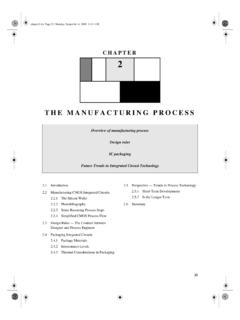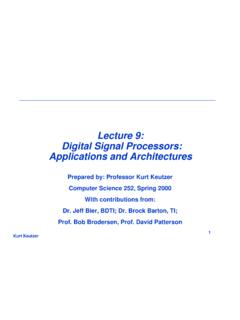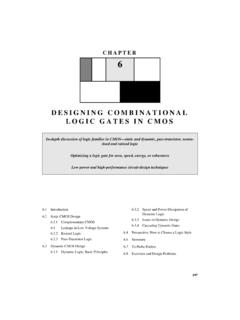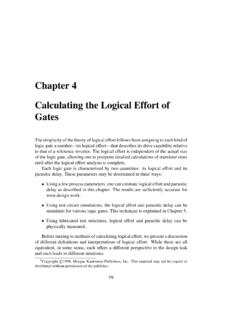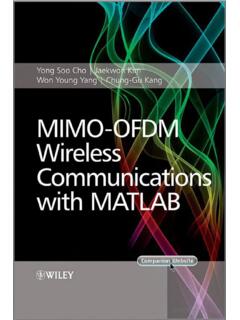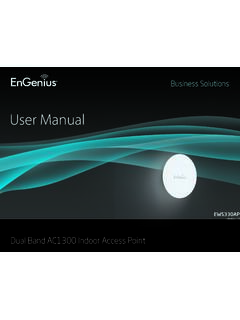Transcription of Introduction to OFDM
1 1E225C Lecture 16 ofdm IntroductionEE225 CEE225 CIntroduction to OFDMlBasic idea Using a large number of parallel narrow-band sub-carriers instead of a single wide-band carrier to transport informationlAdvantages Very easy and efficient in dealing with multi-path Robust again narrow-band interferencelDisadvantages Sensitive to frequency offset and phase noise Peak-to-average problem reduces the power efficiency of RF amplifier at the transmitterlAdopted for various standards DSL, , DAB, DVB2 Multipath can be described in two domains: time and frequencytimetimeSinusoidal signal as inputtimetimeSinusoidal signal as outputfFrequency responseTime domain: Impulse responseFrequency domain: Frequency responsetimeImpulse responsetimetimeModulationtechniques: monocarrier vs.
2 MulticarrierTo improve thespectral efficiency:To use orthogonal carriers (allowing overlapping)Eliminate band guards between carriers Selective Fading Very short pulses ISI iscompartively long EQs are then very long Poor spectral efficiencybecause of band guardsDrawbacks It is easy to exploitFrequency diversity Flat Fadingpercarrier N long pulses ISI iscomparatively short N short EQsneeded Poor spectral efficiencybecause of band guardsAdvantagesFurthermore It allows to deploy2D coding techniques Dynamic signallingNcarriersBPulse length ~N/BSimilar toFDM technique Dataare shared amongseveral carriersand simultaneously transmittedBPulse length~1/B Dataaretransmitedoveronly one
3 CarrierChannelGuard bandsChannelization3 Orthogonal Frequency Division ModulationData coded in frequency domainN carriersBTransformation to time domain:each frequency is a sine wavein time, all added : 8 periods of f0 Symbol: 4 periods of f0 Symbol: 2 periods of f0+ReceivetimeBDecode each frequencybin separatelyChannel frequencyresponseffTime-domain signalFrequency-domain signalOFDM uses multiple carriersto modulate the dataN carriersBModulation techniqueA user utilizes all carriers to transmit its data as coded quantity at each frequency carrier, which can be quadrature-amplitude modulated (QAM).
4 Intercarrier Separation = 1/(symbol duration) No intercarrier guard bands Controlled overlapping of bands Maximum spectral efficiency (Nyquist rate) Very sensitive to freq. synchronization Easy implementation using IFFTsFeaturesDataCarrierT=1/f0 Timef0 BFrequencyOne ofdm symbolTime-frequency grid4 ofdm Modulation and Demodulationusing coded infrequency domain:one symbol at a timeIFFTI nverse fastFourier transformData in time domain:one symbol at a toserial converterTransmit time-domainsamples of one symbold0, d1, d2, .., dN-1 Receive time-domainsamples of one symbold0 , d1 , .., dN-1 S/PSerial toparallel converterd0 d1 d2.
5 DN-1 timeFFTFast Fouriertransformb0 b1 b2 ..bN-1 fDecode eachfrequency binindependentlyLoss of orthogonality(by frequencyoffset) k(t)=exp(jk2 t/T) y k+m(t)=expj2 (k+m)t/T() k+m (t)=expj2 (k+m+ )/T() con 1/2 Transmission pulsesReception pulse with offset 246810121416-60-55-50-45-40-35-30-25-20- 15-10 Total ICIdue to loss of orthogonalityCarrier position within the band (N=16)ICI indB = = = = = = limit assumed = offset: Interference: Im(?)/T endBLoss for8 carriersm=1m=3m=5m=7-70-60-50-40-30-20-1 00Im( )=expjk2 t/T()exp j(k+m+ )2 t/T()dt0T =T1 exp( j2 )()j2 (m+ )Im( )=Tsin m+ Im2( )m T ()21m2m=1N 1 T ()22314forN>>1(N>5Is enough)Interferencebetweenchannelsk andk+mSumming up m Asymetric5 Loss of orthogonality(time)Xi=c0 k(t) l*(t )dt T/2 T/2+ +c1 k(t) l*(t )
6 Dt T/2+ T/2 Let us assumea misadjustment 2 deviation for the relative misadjustmentICI indBN=8N=64 ICI due to loss of orthogonaliy assumed an Uniform practical limitDoublingN means3 dB more ICIEXi2T2 =4 T 212+012=2 T 2 ICI 20log2 T , <<TPercarrierIn average, the interferingpower in any carrier isXiT 2m Tm =2 TOr approximately,when << misadjustment InterferenceendBLoss for16 carriersm=1m=5m=10 ThenXi=2 Tsenm Tm ,c0 c10,c0=c1 Zoneofinterestifm=k-lIncluding a cyclic prefix CPPassing the channel h(n) i(t) j(t)h(n)=(1) n/nn=0,..,23 j(t) i(t) i(t)To combat the time dispersion: including special time guards in the symbol transitionsCPTTc copyFurthemore it converts Linear conv.
7 = Cyclic conv. (Method: overlap-save)CP functions: It acomodatesthe decaying transient of the previous symbol Itavoids the initial transient reachs the current symbolIncluding the Cyclic PrefixSymbol: 8 periods offiSymbol: 4 periods offiInitial transientremains withinthe CPFinal transientremains withinthe CPThe inclusion of a CPmaintains the orthogonalityPassing the channel h(n)Initial transientDecaying transientChannel:Symbol: 8 periods offiSymbol: 4 periods offiWithout the Cyclic PrefixLoss of orthogonality6 Cyclic PrefixTgT maxTxMulti-path componentsTSampling SpecificationlSampling (chip) rate: 20 MHzlChip duration: 50nslNumber of FFT points: 64lFFT symbol period: slCyclic prefix period: 16 chips or s Typical maximum indoor delay spread < 400ns ofdm frame length: 80 chips or 4 s FFT symbol length / ofdm frame length = 4/5lModulation scheme QPSK: 2bits/sample 16 QAM: 4bits/sample 64 QAM: 6bits/samplelCoding.
8 Rate convolutionalcode with constraint length 7GI2T1 GIOFDM SymbolGIOFDM SymbolT2t1t2t3t4t5t6t7t8t9t10 Short training sequence:AGC and frequency offsetLong training sequence:Channel estimation7 Frequency diversity using codingRandom errors: primarily introduced by thermal and circuit errors: introduced by magnitude distortion in channel frequency bitsBad carriersT=1/f0 Timef0 BFrequencyTime-frequency gridFrequency responseErrors are no longer random. Interleaving is often used to scramblethe data bits so that standard error correcting codes can be Mask Frequency (MHz)f carrierPower Spectral Density9112030-9-11-20-30-20 dB-28 dB-40 dB Requires extremely linear power amplifier Channel and Alternate Channel Rejection Requires joint design of the anti-aliasingfilter and ChannelRejectionAlternateChannel rejection6 Mbps-82 dBm16 dB32 dB12 Mbps-79 dBm13 dB29 dB24 Mbps-74 dBm8 dB24 dB36 Mbps-70 dBm4 dB20 dB54 Mbps-65 dBm0 dB15 dB16 dB blocker32 dB blockerSignalFrequencyOFDM Receiver DesignYun Chiu, Dejan Markovic, Haiyun Tang, Ning ZhangEE225C Final Project Report.
9 12 December 20009 ofdm System Block DiagramSynchronizationlFrame detectionlFrequency offset compensationlSampling error Usually less 100ppm and can be ignored 100ppm = off 1% of a sample every 100 samplesTgTFrame start10 System Pilot ofdm TxerShort Preamble Preamble Data PathSignalDataData214735986T1GI2 GIGIGI10 Signal Detection, AGC,Diversity Selection10 x = 8 uST22 x + 2 x = 8 uSChannel & Fine EstimationCoarse Freq. OffsetEst.,Timing + = 8 + = 8 + = 8 uSRate, LengthDataData11 Short & Long Preamblesf-241+j-20-16-12-1-jf-1-16-26+1 -24-12 Short PreambleLong PreamblePeriod = 16 ChipsPeriod = 64 ChipsCorrelation of Short PreambleCorrelationCoarse TimingFine TimingAuto-Correlation12 Synchronization 16Td* **.
10 AGC* **..Short Preamble (LUT)..TdFrom AGCM oving Auto-Corr. UnitMoving SP Corr. UnitImpairments: Multi-Path ChanneltT02Tt0t0T2T3T4 TTcTcCh. Impulse Responset0t0T2T3T4 TTct5TT2T3T4Tt0T2T3T4T5 Ttt0T2T3T4T5 TAuto-Correlation w/ Multi-Path Channel : Frequency Offsett0T2T3T4Tt0T2T3T4 Ttt0T2T3T4 TFine Frequency Offset MultiplierSync. SignalAccumulator14 Coarse-Fine Joint Estimation & Decision Alignment Error Correction0 0 0 0 12376485 0 ADBCVinFolding Signal 00 0 Folding ADCC oarseFine 100ppm fc@ over 16chipsAverage over 64chipsFrequency Offset CompensationJoint Coarse-Fine AlignmentChannel15 Performance Summary 5 = 100ppm@ GHzFreq.
